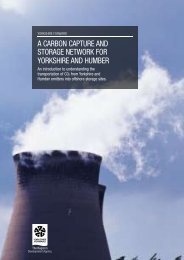Final report for One North East And NEPIC 21/12/10 - The Carbon ...
Final report for One North East And NEPIC 21/12/10 - The Carbon ...
Final report for One North East And NEPIC 21/12/10 - The Carbon ...
You also want an ePaper? Increase the reach of your titles
YUMPU automatically turns print PDFs into web optimized ePapers that Google loves.
<strong>The</strong> case <strong>for</strong> a Tees CCS network<strong>Final</strong> ReportMark „push‟ factors – these relate to economic factors driving emitters to investin capture plant at their installations. This includes consideration of the value atrisk (as highlighted previously), other incentives (such as demonstration projectfinancing), wider Government targets to decarbonise the UK economy, and thecapacity of CCS to attract new businesses and investments in the region (such ascarbon intensive businesses which face exposures in other parts of the EU absentof a CCS network);Market „pull‟ factors – these are more challenging to identify and have not beenreviewed in depth within this study. <strong>The</strong>y could include the use of captured CO 2<strong>for</strong> enhanced oil recovery (EOR) in the southern Central <strong>North</strong> Sea, the attendantenergy security and tax revenues this could deliver <strong>for</strong> Government, and strategicinterests to <strong>North</strong> Sea operators to gain experience in offshore EOR and defer thecosts of decommissioning <strong>North</strong> Sea oil & gas infrastructure.Teesside is in a good position to bring all of these factors into play. CO 2 is already asignificant driver <strong>for</strong> investment decisions <strong>for</strong> the carbon intensive businesses in the TeesValley and this is expected to grow in the next five to ten years and beyond. 44 <strong>The</strong> value atrisk from carbon pricing outlined previously suggests around £8 billion could be at stake inthe region to 2020 (Figure 3; Figure 4). A further £1-2 billion could be available from grantfinancing of CCS demonstration projects from the UK Government and EU fundingsources. New inward investment is an unknown quantity, but could be worth several billionout to 2025 if CCS can attract new business.Furthermore, the technologies involved in CO 2 capture – gas separation, compression andtransport – are familiar technologies to many of the large CO 2 emitters on Teesside. ManyTeesside operators have access to capital <strong>for</strong> investment (either because they operatecash generative businesses or have excellent credit ratings) and already operate withinchallenging health, safety and environmental per<strong>for</strong>mance management systemsassociated with these technologies. Extension to CCS will require a degree of „up-skilling‟but is unlikely to require a shift in working culture or practices <strong>for</strong> those used to workingwithin the chemical/process industries or their regulators.On the market pull side, if Teesside‟s current emissions could be used <strong>for</strong> EOR, severalmillion barrels of oil per year could be extracted from the Central <strong>North</strong> Sea, potentiallyadding up to several billions of pounds to the UK economy, depending on the oil price andproject lifetime.In addition, the region has midstream capabilities to deliver the shared infrastructure thatwould be needed. Businesses in Teesside already share pipeline infrastructure (<strong>for</strong> steam,hydrogen, oxygen and wastes), so corporate capacity to develop appropriate contractualstructures is already present. This existing institutional capacity could unlock the potential<strong>for</strong> commercial organisations to own and operate capture, transport and storageinfrastructure, without the need <strong>for</strong> excessive public intervention or oversight. Takentogether, these competencies could facilitate CCS deployment in Teesside as and whenrequired.In the context of a CCS demonstration programme providing one or more „Anchor‟projects, a value chain <strong>for</strong> a CO 2 pipeline network is shown in Figure 6, which highlightsmarket „push‟ and „pull‟ factors.44 Result taken from a survey of local stakeholders <strong>for</strong> this project. See Appendix I16







